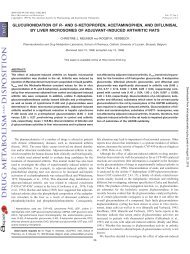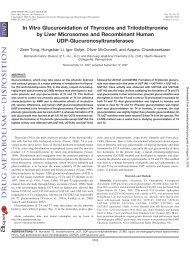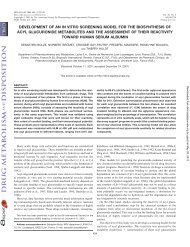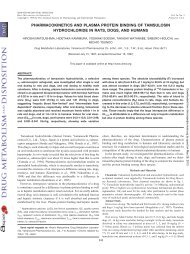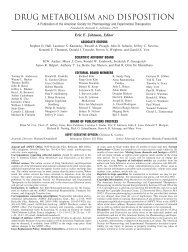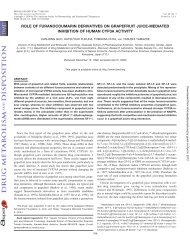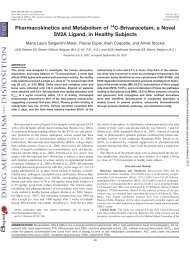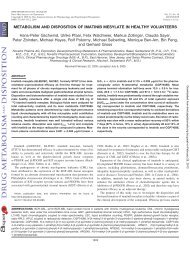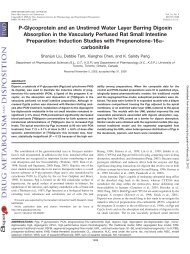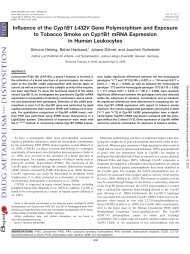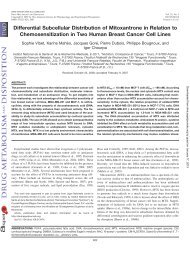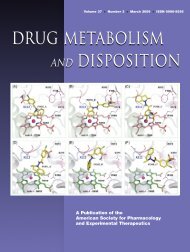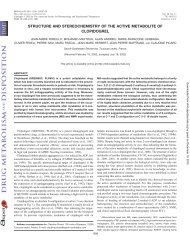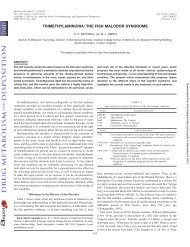DMD #048264 1 Discovery and Characterization of Novel, Potent ...
DMD #048264 1 Discovery and Characterization of Novel, Potent ...
DMD #048264 1 Discovery and Characterization of Novel, Potent ...
Create successful ePaper yourself
Turn your PDF publications into a flip-book with our unique Google optimized e-Paper software.
<strong>DMD</strong> <strong>#048264</strong><br />
We further subjected the two complex systems to all-atom molecular dynamics<br />
simulation. The CYP2J2 protein displays limited overall conformational change in both<br />
systems, while the inhibitor telmisartan exhibits greater conformational flexibility than<br />
flunarizine within the CYP2J2 binding pockets (Figure 5, panels C <strong>and</strong> D).<br />
As shown in Figure 6, telmisartan binds to a pocket that is remote to the<br />
catalytically important heme with a minimum distance between telmisartan <strong>and</strong> heme <strong>of</strong><br />
about 8 Å. The pocket is largely comprised <strong>of</strong> residues <strong>of</strong> hydrophobic nature, mainly<br />
from N-terminal loop <strong>and</strong> helix A, sheet β1 <strong>and</strong> associated loops, helix K’, sheet β4 <strong>and</strong><br />
associate loop, K/β1-4 segment, B/C segment, helix F, as well as F/G segment (Figure 6,<br />
panels A <strong>and</strong> C). On the other h<strong>and</strong>, flunarizine binds directly within the active site <strong>of</strong><br />
CYP2J2 with the F atom right on top <strong>of</strong> the heme Fe ion, presumably blocking substrate<br />
binding. The binding pocket is also formed primarily by hydrophobic residues, largely<br />
from N-terminal loop <strong>and</strong> helix A, sheet β4 <strong>and</strong> associate loop, K/β1-4 segment, B/C<br />
segment, helix F, as well as helix I <strong>and</strong> the heme porphyrin ring (Figure 6, panels B <strong>and</strong><br />
D).<br />
To further study how telmisartan <strong>and</strong> flunarizine interact with CYP2J2 from a<br />
thermodynamics point <strong>of</strong> view, we carried out MM-GBSA calculation to estimate the<br />
inhibitor binding free energy to CYP2J2 (Table 4). The binding free energy (without<br />
considering the entropy) between telmisartan <strong>and</strong> CYP2J2 protein is –55.5 kcal/mol,<br />
slightly lower than that for flunarizine (–52.8 kcal/mol). This is consistent with the<br />
similar inhibition IC50 values <strong>of</strong> the two drugs, where telmisartan (0.42 μM) is<br />
marginally more potent than flunarizine (0.94 μM). The binding energies observed here<br />
are generally in line with structural observation. Specifically, given the predominantly<br />
lipophilic nature <strong>of</strong> the CYP2J2 binding pocket <strong>and</strong> a larger estimated hydrophobic<br />
20



